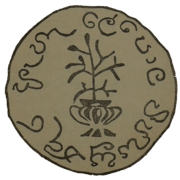Ehelepola Nilame
| Ehelepola | |
|---|---|
.jpg) Ehelepola Maha Nilame. | |
| Born |
Ehelapola Wijayasundara Wickremasinghe Chandrasekara Amarakoon Wasala Ranamuka Mudiyanse 1773 Sinhale |
| Died |
1829 Mauritius |
| Occupation | Adigar |
| Religion | Theravada Buddhism |
Ehelapola Wijayasundara Wickremasinghe Chandrasekara Amarakoon Wasala Ranamuka Mudiyanse (Sinhalese: ඇහැලේපොළ මහ නිලමේ; 1773 - 1829) known as Ehelapola Nilame was a courtier of the Kingdom of Kandy. He was the 1st Adigar (Maha Adikaram) from 1811 to 1814 under the reign King Sri Vikrama Rajasinha. Following the brutal execution of his entire family by the King, he aided the British in launching an invasion of the Kandy Kingdom and was instrumental in the Kandyan Convention that followed which led to the annexed the Kandy Kingdom to the British Empire.[1]
Early life
He was born to a Radala family of courtiers who hailed from the village of Ehelepola, nine miles from Matale and was educated by the Yatawatte Maha Thera (Chief Priest Yatawatte) before joining the Royal court as part of the Royal household.
Royal service

His first appointment was to the post of Paniwidakara Nilame by the King later he was appointed 2nd Adigar in 1808 succeeding Megastenne on his death. Ehelepola was appointed as Dissava of Sabaragamuva which was held by Megastenne. Sath Korale, which was also held by Megastenne was divided between Molligoda and Ehelepola which was unprecedented and caused much unrest amongst the populaces and resulted in riots in 1811 which had to be put down by Pilimatalawwe Nilame the 1st Adigar and Ehelepola's uncle. It also lead to much animosity between Molligoda and Ehelepola. In 1811, Pilimatalawwe was be-headed after he was convicted of high treason for attempting to remove the King and replace him with the young Prince Kannasamy. Ehelepola was thereafter appointed as Maha Adigaram in 1811. The King became increasingly suspicious of the Radala families and his courtiers. His suppression of his repressived enemies were brutal and soon the King became unpopular among his chiefs and people.
Rebellion
Soon the King fell out of favor with the Ehelepola and when a revolt broke out in Sabaragamuva, Ehelepola was sent to suppress it. When Ehelepola failed to return on the Kings summons, he sent Molligoda to capture and return with Ehelepola. Following an engagement with Molligoda's men, Ehelepola fled to the protection of the British forces in the coastal areas of the island.
In the mean time Molligoda returned to Kandy with forty-seven chiefs of Sabaragamuwa as prisoners, they were executed in a day followed by the brutal execution of Ehelepola's family. On orders of the King Ehelepola's young sons aged 10 and 8 where executed along with his brother Ehelepola Disswa. Legend has it that when Ehelepola's eldest son ran to his mother at the sight of the executioner, his younger son Maduma Bandara stepped forward bravely and asked to be executed first. His infant son was placed in a rice pounder and pounded to death and the Ehelepola's wife Ehelepola Kumarihamy, their daughters and his sister-in-law were drowned in the Kandy lake.
Following these executions the King lost support of the people and riots began to breakout and the King fled to Hanguranketha. Under the advice of Ehelepola, who had found out about the fate of his family the British invaded the Kandy Kingdom in January 1815 unopposed and entered the city of Kandy. The Kandyan Convention was signed in March recognizing the British Monarchy. The King of Kandy, Sri Vikrama Rajasinha was shortly captured and exiled to India.
Later life and death
Ehelepola became part of the British administration of Kandy but soon came under suspicion with Great Rebellion of 1817–18 he was arrested by the British and exiled to Mauritius along with several Kandian Chiefs. He died there in 1829.[1]